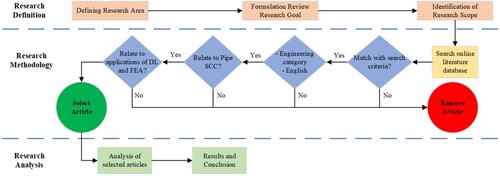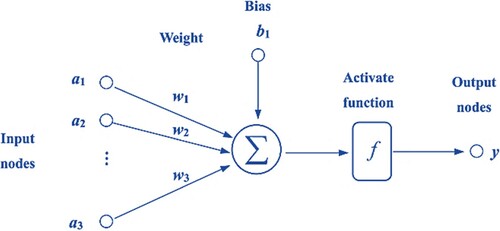 ?Mathematical formulae have been encoded as MathML and are displayed in this HTML version using MathJax in order to improve their display. Uncheck the box to turn MathJax off. This feature requires Javascript. Click on a formula to zoom.
?Mathematical formulae have been encoded as MathML and are displayed in this HTML version using MathJax in order to improve their display. Uncheck the box to turn MathJax off. This feature requires Javascript. Click on a formula to zoom.Abstract
Pipelines are crucial for transporting energy sources, yet corrosion especially stress corrosion cracking (SCC) poses a complex and potentially catastrophic form of material degradation. Traditional techniques like finite element analysis (FEA) have been utilized for SCC prediction, but it suffers from high computational cost and limited scalability. Deep learning (DL) with integration of FEA leverages large-scale data and learn complex nonlinear patterns for SCC prediction. Currently, literature on deep learning-enabled finite element analysis for pipelines SCC prediction is scarce, offering limited insights into this emerging approach and lack of comprehensive review. This paper reviews and investigates the current research directions and applications of DL-enabled FEA methodologies for simulation of SCC prediction. The importance of DL, technique type and network are also outlined in this review paper. This paper delves into integration of DL algorithms with FEA and their ability to grab complex interactions between mechanical stress, material properties, and environmental factors. Based on this comprehensive review, it was found that DL and FEA have proven to be strong prediction tools with high accuracy and lower training cost. DL-enabled FEA techniques are also being utilized to replace time-consuming methods and conventional codes. Furthermore, article discusses potential of this integrated approach for enhancing accuracy and efficiency of SCC prediction, leading to improved pipeline integrity management practices.
Abbreviations: SCC: Stress corrosion cracking; FE: Finite element; FEA: Finite element analysis; FEM: Finite element method; ML: Machine learning; DL: Deep learning; EGIG: European gas pipeline incident data group; PHMSA: Pipeline and hazardous materials safety administration; DNNs: Deep neural networks; HpHSCC: High pH stress corrosion cracking; SMYS: Specified minimum yield strength; HE: Hydrogen embrittlement; NNpHSCC: Near-neutral pH stress corrosion cracking; ASME: American society of mechanical engineers; DNV: Det norske veritas; AI-FEM: Advanced iterative finite element method; CGR: Crack growth rate; ME: Mechanoelectrochemical; XGB: XGBoost; CAT: Catboost; CP: Cathodic Protection; AI: Artificial intelligence; ANNs: Artificial neural networks; CNNs: Convolutional neural networks; RNNs: Recurrent neural networks; ReLU: Rectified linear unit
1. Introduction
Pipelines are an integral part of the infrastructure, and they play a highly crucial role in transporting oil, gas, and other fluids. They are regarded as being a reliable, efficient and cost-effective method of transporting oil and gas around the world and have an excellent safety record (Kishawy & Gabbar, Citation2010). These fossil fuels (oil, gas and coal) are currently important assets generating more than 80% of energy of the world today (I.E.A., Citation2022). The pipeline integrity is embarrassed when pipeline deterioration takes place on the walls of pipeline. Pipelines are subjected to various external and internal forces that can lead to the development of cracks and other defects due to corrosion (Parlak & Yavasoglu, Citation2023). One of the significant challenges in the design and maintenance of pipelines is the prediction of corrosion. The consequences of pipeline corrosion are wide-ranging. Besides compromising the pipelines’ structural integrity, corrosion can lead to product contamination, reduced flow efficiency, increased maintenance costs, and environmental pollution (Bony et al., Citation2010; Iqbal et al., Citation2017). Therefore, effective corrosion management strategies are essential to ensure the safety, reliability, and longevity of pipeline systems.
Corrosion is natural process and one important significant challenging feature of engineering and science because of its interdisciplinary nature (Kishawy & Gabbar, Citation2010; Wasim & Djukic, Citation2022). To comprehend corrosion, one needs knowledge from diverse areas like Material Science, Mechanics/Engineering, and especially Chemistry, as chemical reactions are often involved in corrosion phenomena (Menon, Citation2011). Corrosion refers to the deterioration or destruction of a metal through a reaction with the surrounding environment (Orazem, Citation2014). Steel corrosion is a process of electrochemical, which includes oxidization of iron in the steel and generates rust. Previous research has shown that corrosion is the most critical failure mechanism in transmission pipelines, which may occur either externally or internally (Akhlaghi et al., Citation2023). Approximately 26–40% of recorded pipeline incidents and failures are attributed to corrosion damage as shown in Figure (E.G.P.I.D.G, Citation2020; (P.a.H.M.S.A, Citation2018). Pipeline corrosion is a complex phenomenon influenced by multiple factors, including the nature of transported fluid, operating conditions, environmental factors, and the properties of the pipeline materials.
Figure 1. (a) European Gas Pipeline Incident Data Group (EGPIDG) distribution of pipeline incidents (E.G.P.I.D.G, Citation2020), (b) Pipeline and Hazardous Materials Safety Administration (PaHMSA) pipeline failure causes ( P.a.H.M.S.A, Citation2018).
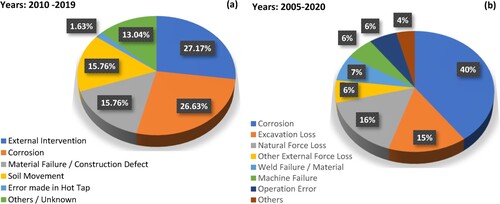
Corrosion and high operating pressure together can considerably diminish the structural integrity and lifespan of oil and gas pipelines (Wasim & Djukic, Citation2022). The corrosion process can manifest in different forms, such as localized pitting corrosion, uniform corrosion, stepwise cracking, stress corrosion cracking (SCC), etc. (Soomro et al., Citation2022) as shown in Figure ; some of which include mild risks while others can lead to disastrous engineering materials’ failures. This study focuses on SCC, one of the serious forms of corrosion and very challenging to detect (Alamri, Citation2022). SCC has become a common problem for most oil and gas pipelines, which caused gas pipeline accidents recorded. One of the recent reported incidents of natural gas pipeline explosion in Arizona, USA that caused the death 02 people and incurred a loss $5.5 million (DuBose, Citation2023). SCC typically occurs when pipelines are subjected to stress from internal fluid movement or external forces while being exposed to a corrosive environment.
Figure 2. Corrosion’s different forms in pipeline (Askari et al., Citation2019).
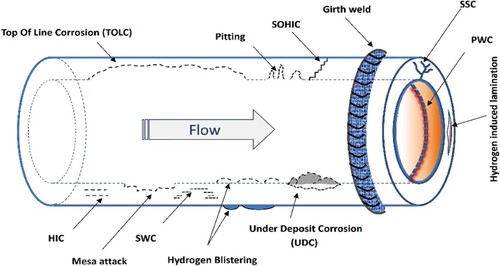
The identification and prediction of SCC occurrence pose significant challenges for corrosion engineers and corrosion scientists. Over the years, various methods have been developed and used to predict the SCC of pipelines include empirical formula, machine learning (ML) algorithms, and traditional methods like Monte Carlo simulation (Vijaya Kumar, Lo Yin Kai, et al., Citation2021). This effort was driven by the need for an accurate failure pressure prediction method in the industry. However, the conventional SCC assessment procedures result in predictions that are conservative due to the incorporation of safety factors in the calculations, consider one factor that has great impact on SCC, great amount of time to produce results and less performance accuracy. With the recent technology advancement and fourth industrial revolution (4.0) (Alamri, Citation2022; Völker et al., Citation2020), understanding and prediction of pipeline SCC have been significantly enhanced by the application of computational models, like finite element analysis (FEA) and computational fluid dynamics. These models simulate the interaction between the pipeline materials, corrosive environment, and operating conditions, providing valuable insights into the corrosion mechanisms and potential failure modes. By incorporating factors like flow dynamics, fluid composition, temperature, and the electrochemical behaviour of the materials, these models support in predicting corrosion rates, identifying critical areas prone to corrosion, and optimizing corrosion control measures. FEA is one of the powerful tools that can be utilized to predict the onset and propagation of SCC in pipelines (Vijaya Kumar, Lo Yin Kai, et al., Citation2021). Although FEA has demonstrated excellent performance in solving problems with corroded pipelines, it is computationally expensive, time-consuming, and precisely predicting SCC is challenging due to the complex nature of the problem and the lack of comprehensive models that consider all relevant factors. To overcome this, deep learning (DL) is an approach to mitigate these challenges with integration of FEA.
Recently, machine learning (ML) has become very widespread in research and has been incorporated in a variety of applications, including corrosion prediction. The use of machine learning to predict occurrence of stress corrosion cracking is relatively a new topic with less literature available (Alamri, Citation2022). DL is one of the techniques used in machine learning. DL has appeared as a powerful tool in various domains for solving complex problems. DL models, particularly deep neural networks (DNNs), have shown impressive capabilities in image recognition, natural language processing, and other pattern recognition tasks (Petricca et al., Citation2016). Leveraging the ability of DL to extract complex patterns and relationships from large datasets, researchers have begun to explore its potential in the field of structural engineering and materials science.
The integration of DL with FEA holds great promise for improving the prediction efficiency and accuracy of SCC in pipelines. By combining the strengths of both approaches, it is now possible to develop a hybrid model that can capture the intricate interactions between stress, corrosion, and crack propagation (Ji et al., Citation2023; Su et al., Citation2021). This deep learning-enabled FEA approach can leverage the vast amounts of collected data from the inspections of pipeline, operational conditions, and laboratory experiments to train and fine-tune the model, enabling it to generate more precise predictions. DL-enabled FEA approach has widely been used in other fields with high performance like civil engineering, computer science, etc. but there is a literature scarcity on the application of deep learning-enabled FEA for the prediction of SCC in pipelines, resulting in a dearth of comprehensive insights into this emerging approach. In this paper, an effort has been made to review the available relevant studies on the DL and FEA applications for SCC in pipelines. The aim of this work is to provide a comprehensive overview of SCC prediction models using FEA and DL to guarantee the safe serving of oil and gas pipelines. Furthermore, this paper presents the current state of the art regarding the fundamentals of DL, FEA, and SCC. The current knowledge gaps are described and the future directions of research for utilizing DL and FEA in assessing corrosion risks associated with SCC are outlined.
2. Corrosion mechanism of stress corrosion cracking
SCC indicates the failure of engineering materials due to the gradual propagation of cracks induced by environmental factors. The understanding of SCC began during the 1930s and 1950s, with the mechanism being discussed in 1960s and 1970s and development and its applications started in 1980s (Ahmad, Citation2006). However, the industries didn’t discover the severity of the problems related to the SCC until the catastrophic rupture of a digester in 1980 at Pine Hill, Alabama (Bennett, Citation1981). In this incident, caustic cracks were identified in shell welds. Caustic SCC is form of the combined effects of a caustic environment and either applied or residual tensile stress. The morphology of caustic cracking is intergranular with a lower limit for cracking of carbon steel in the range 1–5% NaOH (caustic soda). This phenomenon mostly occurs in boilers where NaOH has been added in small amounts to boiler water to prevent scaling.
Several other disasters have also involved SCC, including the rupture of high-pressure gas transmission pipes, the explosion of boilers, and the destruction of power stations and oil refineries. SCC is induced by mixed reaction of simultaneous a susceptible material, an environment that causes SCC for that material, and sufficient tensile stress (applied or residual) to induce SCC (Cicek, Citation2014; Davis, Citation2000), Figure . Beavers & Harle, Citation1996 discussed three main controlling factors for SCC to meet simultaneously on an engineering structure; (a) a specific crack-promoting environment including its pH value; (b) the metallurgy of the material susceptibility to SCC; and (c) the level of tensile stresses in the pipeline wall which can be above some threshold value. The threshold stress for SCC can vary depending on several factors, including the material composition of the pipeline, the type and concentration of corrosive environment, temperature, and the presence of residual stresses. Based on the corrosive media/metal type combination, SCC cracks typically propagate transgranularly and/or intergranularly. In the mode of transgranular cracking, crack forms through the individual grains of a material, however in the mode of intergranular cracking, crack forms with the grain boundaries of a material (Abubakar et al., Citation2022; Ahmad, Citation2006).
Figure 3. Critical conditions for stress corrosion cracking (Rao, Citation2021).
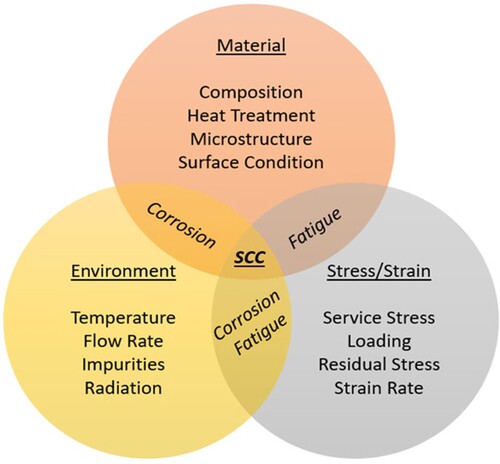
Mainly there are two types of SCC that have been defined for the steel pipeline in literature: high pH SCC and near-neutral pH SCC (Bueno et al., Citation2014). High pH SCC is characterized by an intergranular cracking mode and has been studied in condensed carbonate/bicarbonate environments with higher pH values (more than 8.5–11). Contrarily, near-neutral SCC is characterized by a transgranular mode of cracking with pH values 5.5–7.5 and is associated with dilute carbonate/bicarbonate medium (Majchrowicz et al., Citation2019; Omura et al., Citation2009). Figure a & b respectively show the examples of transgranular and intergranular morphology of SCC on steel pipelines.
Figure 4. Morphology of SCC on steel pipeline surfaces; (a) SCC of transgranular mode; (b) SCC of intergranular mode (Abubakar et al., Citation2022).
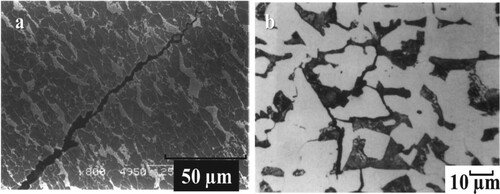
2.1. High pH stress corrosion cracking
The high pH SCC (HpHSCC) mechanism is reported due to the carbonate and bicarbonates presence in soil, high pH values, and on aged pipelines (≤ 10 years in service). HpHSCC indicates to a particular type of corrosion phenomenon that occurs in materials exposed to an alkaline or high pH environment, commencing to the development of cracks and eventual failure (Niazi et al., Citation2021). Approximately 85% failures of pipeline recorded in North America between 1965 and 2010 were caused by HpHSCC, which occur when pipeline wall experiences hoop stress at threshold level induced by the internal pressure (Wasim & Djukic, Citation2022). This threshold stress was determined to be more than 60% of the defined minimum yield stress (SMYS) for the steel pipeline in use (Beavers & Harle, Citation1996). Figure depicts a model representing the HpHSCC time-dependent behaviour in a steel pipeline, named as the bathtub model. This bathtub model originally was proposed by Parkins Citation1990. Table further explains in detail each process of bathtub model’s stages.
Figure 5. HpHSCC’s time dependent initiation and growth of crack under conditions of field (Niazi et al., Citation2020).
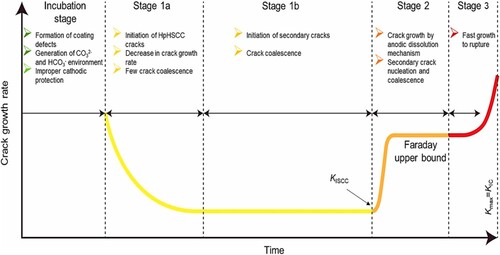
Table 1. Typical Stages of HpHSCC.
Detecting and mitigating HpHSCC needs a detailed understanding of the material properties, environmental conditions, and stress factors involved. Until now, substantial research endeavours have been dedicated to comprehending the HpHSCC phenomena by investigating the environmental, mechanical, and metallurgical parameters that contribute to it (Beavers & Bubenik, Citation2017). In the field, HpHSCC environment generation is time-consuming process and the time changes based on the coatings, locations, and ambient temperatures (Song, Citation2010). Interestingly, in certain cases, the alloying elements presence enhanced the resistance of steel against the formation of HpHSCC cracks. Roccisano et al., Citation2020 conducted a study on cracked X42 and X65 pipeline steel to determine the physical properties effect on SCC growth. Results confirmed that cracked grain boundaries were mostly high angle grain boundaries both across and along the crack, and most of coincident site lattice boundaries didn’t determine increased resistance to SCC. Similarly, Zhu et al., Citation2014 explored the susceptibility of X65 and X80 steel pipeline to SCC under conditions of HpHSCC environmental. The findings revealed that high strength X80 steel pipeline exhibited the resistance against intergranular cracking unlike X65 steel. On other hand, X80 steel displayed the susceptibility to transgranular cracking due to the interference of hydrogen embrittlement (HE). Wang, Niazi, et al. (Citation2021) also studied the effect of strain-shock on HpHSCC pipeline steels. The experimental results showed that strain-shock caused by discontinuous yielding of pipeline steels under load-control, can enhance the early stage of crack initiation and growth in HpHSCC environment. The available literature provides valuable insight into this phenomenon. However, these literatures have focused less on the interactions among contributing parameters at each stage of HpHSCC. Overall, HpHSCC represents a significant challenge in industries where alkaline environments are encountered.
2.2. Near-neutral pH stress corrosion cracking
Near-Neutral pH stress corrosion cracking (NNpHSCC) is of particular concern in industries like oil and gas, where pipelines and equipment may come into contact with aqueous solutions containing dissolved gases, contaminants, or various chemical species (Sun et al., Citation2021). These mildly acidic or neutral environments can accelerate the corrosion process, leading to the crack initiation and propagation in susceptible materials under the influence of tensile stress. NNpHSCC is less influenced by temperature compared to HpHSCC (Baker, Citation2018). The susceptibility of a metal or alloy to SCC is affected by its chemical composition and microstructure. The associated microstructure types have evolved from ferrite-pearlite for steels of strength lower than X60 to acicular-ferrite/bainite for X80 and higher-grade steels (Abubakar et al., Citation2022). Investigation of the effect of different microstructural types on anodic dissolution helps understand the NNpHSCC mechanism. There is a report that the hard and brittle phases in steels are more prone to NNpHSCC crack propagation (Zhang et al., Citation2022). During the SCC of steel pipelines in near-neutral solutions, the primary corrosion mechanisms observed are HE and anodic dissolution. HE is explained as the reduction or loss of the tensile strength and ductility in a metal because of the hydrogen atoms diffusion into its crystalline structures at the time of corrosion process (Cicek, Citation2014; Sastri, Citation2015).
HE leads to early brittle fracture of usually ductile metals in applied stresses than the metal’s yield strength (Davis, Citation2000). In the case of carbon steel normally experienced in an aqueous medium, HE often includes CO2. The reactions of corrosion can be defined as follows: CO2 reacts with H2O to produce H2CO3 (carbonic acid), which further disbands into HCO3−, CO32− and H+ (Wei et al., Citation2016). The primary cathodic reactions involve the reduction of H2CO3 H+, and HCO3− as described below (Mu & Zhao, Citation2010; Nesic et al., Citation1996):
(1)
(1)
(2)
(2)
(3)
(3)
(4)
(4)
As indicated by authors (Mu & Zhao, Citation2010; Nesic et al., Citation1996), in an aqueous CO2 medium with pH values 4–6, the dominant reaction involves the reduction of H2CO3 and HCO3−. However, at lower pH values, the reduction of H+ becomes more significant. On the other hand, the major anodic reactions encompass the dissolution of iron (Fe) followed by the formation of iron carbonate (FeCO3) as depicted below (Mu & Zhao, Citation2010; Nesic et al., Citation1996):
(5)
(5)
(6)
(6)
Anodic dissolution, or metal dissolution, refers to the process where the metal is dissolved during corrosion from the anodic site. Simultaneously, gases are emitted at the metal surface and from the cathodic site (Bhattacharyya, Citation2015). Contreras et al., Citation2012 demonstrated that X52 carbon steel susceptibility to SCC tested in NS4 solution increased with increment of both ultimate tensile stress and yield stress. Contreras et al., Citation2017 also examined the API 5L X52 carbon steel susceptibility to SCC by using the slow strain rate technique with strain rate of 1 × 10−6 in/s. The specimens were subjected to exposure both in air and within NS4 solution of 5, 8 and 10 pH levels. The experiment results revealed that specimens exposed in air have higher time to failure, and lower time to failure for specimens exposed in NS4 solution with pH 8. On other hand, Lu et al., Citation2010 postulated that the propagation of crack in steel pipeline submerged in NNpH groundwater is controlled by the concentration of dissolved hydrogen and less influence of anodic dissolution. Liu et al., Citation2012 also recommended in the article that hydrogen plays pivotal role in the context of NNpHSCC in steel pipeline through the HE mechanism.
3. Methodology
The methodological framework used in this research is adapted from Rachman et al., Citation2021, which consists of three essential stages: research definition, research methodology, and research analysis, as shown in Figure . Researchers have conducted several studies on identification and prediction of SCC in various sectors, including the energy sector. This section presents a systematic literature review method to study the behaviour and prediction of SCC for energy pipeline integrity management comprehensively. The main benefit of systematic review over other types of studies is that it is a process that presents a taxonomical review to find the answer to the problems identified related to a specific research topic.
The Scopus search along with Web of Science and Google Scholar search was used to find papers on the SCC of oil and gas pipelines. Search strategy, selection criteria, inclusion and exclusion criteria, and quality assessment and finally data extraction methods have been defined in Ref. (Moher et al., Citation2010). Following the developed method, the searching criteria are developed as follows: ((‘stress corrosion’) AND (‘pipeline*’) AND (‘oil’ OR ‘gas’) AND (‘reliability’ OR ‘probability of failure’ OR ‘corrosion crack’) AND (‘Finite element analysis’ AND ‘Deep learning’)). After searching the articles using the developed strategy, the inclusion and exclusion criteria as shown in Figure are adopted.
Defining the review question is an important and essential first step in a systematic review (Khan et al., Citation2003). Therefore, a focus review question needs to be developed to identify the fundamental concepts of the research topic. The review aims to answer the following research questions:
Q1. What DL architectures and algorithms are most effective for enhancing the accuracy of SCC prediction in FEA?
Q2. How can DL models be integrated with FEA to account for complex material behaviours, including time-dependent properties and environmental factors affecting SCC?
Q3. What is the impact of data quality and quantity on the performance of DL-enabled FEA for SCC prediction, and how can these challenges be addressed?
Q4. What are the key challenges and limitations associated with interpretability and explainability of DL models in the context of SCC prediction?
The above research questions are answered and explained in detail in Section 5.2 and 6 with the discussion of case studies and their results. The research scope of the paper is a literature review of the integration of DL and FEA applications in prediction of pipeline’s SCC initiation and growth. This interdisciplinary field involves the investigation of DL architectures to enhance the accuracy and efficiency of SCC prediction within FEA. Researchers will focus on refining material behaviour models to capture the complex and time-dependent properties of materials under stress corrosion conditions, accounting for environmental factors like temperature and pH levels. This comprehensive research scope aims to advance the understanding and application of DL within FEA to improve the safety and integrity of critical infrastructure.
4. Overview of finite element modelling
Finite element (FE) modelling is a valuable approach for solving nonlinear problems in engineering structures. It involves the use of finite element method (FEM), a numerical method employed to address complex engineering problems (Vijaya Kumar, Lo Yin Kai, et al., Citation2021). The FE method is the preferred numerical method for assessing the integrity of a pipelines, and it can be implemented through widely available commercial FE modelling software like ANSYS, COMSOL Multiphysics, ABAQUS, and ALTAIR HyperWorks (Dickinson et al., Citation2014; Mok et al., Citation1991; Zhang et al., Citation2023; Zhang & Tian, Citation2022). FE modelling is used to solve non-linear problems in engineering structures. Local corrosion defects, depending on geometric features, can be simplified as a 3D equal-depth corrosion (i.e. approximately cuboid), a semi-ellipsoid or a hemisphere (Qin & Cheng, Citation2021). Because of the conservative nature of assessment codes of the current corrosion, FE modelling is extensively utilized and classified as a Level 3 method of assessment by American Society of Mechanical Engineers (ASME) for evaluating the pipelines’ failure pressure (Engineers, Citation2012). Level 3-assessment method is recognized as the most advanced level, where the numerical methods are employed to incorporate more information for the failure pressure prediction compared to 0, 1, and 2 Levels. Various evaluation levels exist for the corroded pipelines, and the selection of evaluation level depends on the type and availability of data. The evaluation method of Level 3 utilizes numerical methods, such as FE modelling to accurately predict the failure pressure (Ma et al., Citation2023). The stepwise development of FEM flow is depicted in Figure .
Figure 7. The flow of FEM development (Szabó & Babuška, Citation2011).

In FE modelling, the complex physical systems existing in the real world are translated into mathematical models to predict the responses of interest. The operational conditions of buried pipelines are notably under various stresses. As shown in Figure , these stresses are illustrating the complex scenarios pipelines encounter. The primary stress originates from the internal pressure experienced by pipelines. Practically pipelines are also introduced with additional stresses (referred as secondary stresses) because of exerting either compressive stress or longitudinal tensile on the pipeline, and soil movement in geohazard regions, (Wang et al., Citation2019). Furthermore, scenarios such as pipeline suspension can introduce bending moments (Cunha et al., Citation2014). Notably, temperature differences lead to a bending moment and an axial force in the wall of pipe (Mondal & Dhar, Citation2019). All these stresses significantly influence the cracking of corroded pipelines. In the context of FE modelling, it is customary to apply external stresses and nonlinear boundary conditions in the longitudinal direction to simulate the secondary stresses experienced by pipelines (Wu & Li, Citation2019; Ying et al., Citation2019).
Figure 8. Corroded pipeline diagram (a) an axial compressive stress (b) an axial tensile stress (c) a closing bending moment (d) an opening bending moment (e) surface loading in pipeline-soil model (f) internal pressure. (Qin & Cheng, Citation2021).
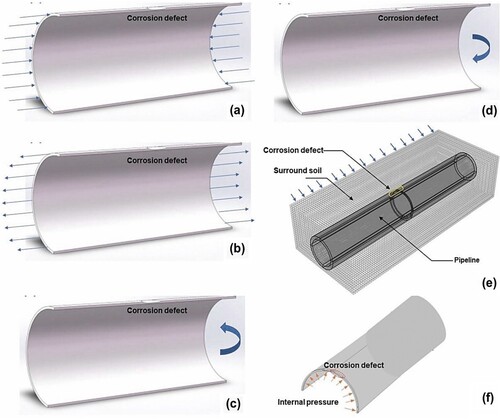
In recent years, FEA has undergone significant advancements, revolutionizing its capabilities for various engineering applications. Similarly, FEA has also been observed in contributing improved the prediction capabilities for SCC in pipelines. This concept encapsulates the ongoing progress, novel methodologies, and enhanced approaches that utilize FEA techniques to gain deeper insights into the initiation and growth behaviour of SCC in diverse materials and structural components (Barbero, Citation2023). The use of advanced constitutive models that capture the nonlinear and time-dependent behaviour of materials under stress corrosion. The development of adaptive mesh refinement techniques that optimize the discretization of the domain and reduce the computational cost. The implementation of multiscale and multiphysics approaches that couple different scales and physical phenomena, such as fluid flow, heat transfer, and electrochemistry. Additionally, FEA is also increasingly used to model hydrogen embrittlement and simulate crack growth, aiding in the prediction of crack initiation and propagation. Accurate prediction of stress corrosion crack’s initiation, propagation, and growth is critical for proactive maintenance and risk mitigation strategies. These developments represent a dynamic intersection of materials science, computational mechanics, and corrosion engineering, with the goal of providing more accurate assessments and predictive modelling of SCC-related risks (Qin et al., Citation2023).
4.1. Prediction models for SCC in pipeline using FEA
SCC is a critical threat to the integrity of pipelines, and predictive techniques are essential for pipeline management. FEA is a widely used tool for predicting SCC in pipelines. Griggs et al., Citation2016 reviewed the modelling of intergranular SCC in pipelines and emphasized importance of predictive techniques in pipeline integrity and management. Qin et al., Citation2021 developed FE-based model to measure 3D corrosion defect growth on X100 pipe steel and failure pressure prediction by using mechanoelectrochemical interaction. The results showed that corrosion defect growth rate pursued the order of depth, length, and width of defect. The flowchart of FE modelling for 3D growth of corrosion defect is shown in Figure . Similarly, Liu et al., Citation2022 also highlighted the difficulty of precise SCC (both HpHSCC and NNpHSCC) growth prediction due to data uncertainty in pipeline operation. Vijaya Kumar et al., Citation2023 proposed set of empirical equations, using FEA and ANN for the failure pressure prediction of pipe elbows depending on combined loadings, as presented in Figure . The results demonstrated that defect depth; defect length, axial compressive stress, and longitudinal spacing affected the elbow of corroded pipe’s failure pressure.
Figure 9. The flowchart of FE model for 3D corrosion defect growth (Qin et al., Citation2021).
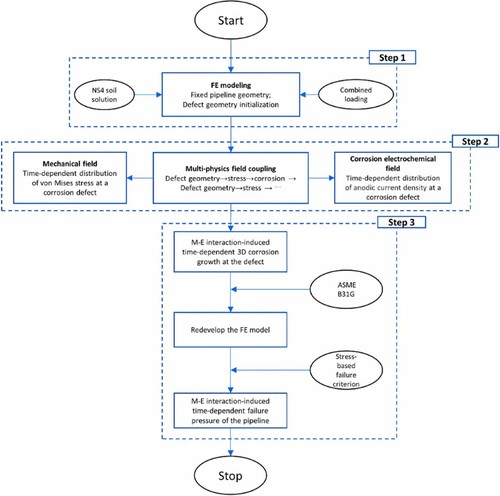
Figure 10. The research flow of failure pressure prediction using FEA and ANN (Vijaya Kumar et al., Citation2023).
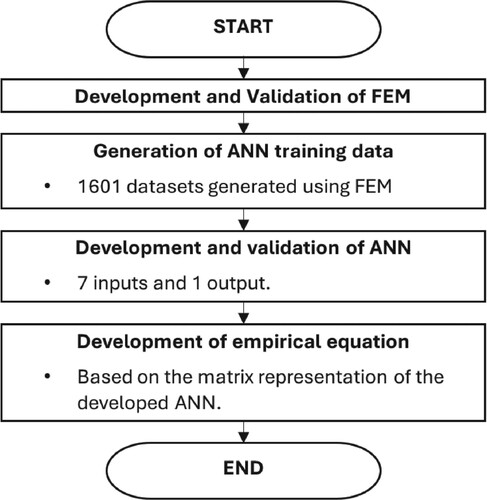
Huang et al., Citation2017 proposed that FEA accurately predicts the stress and FE modelling serves as valuable advanced design tool for assessing pipeline on-bottom roughness and analysing free span behaviour. The proposed flowchart of the analysis is shown in Figure . Moreover, Lo et al., Citation2022 derived an equation, based on ANN model trained on FEA outcomes, to predict the remaining strength of pipelines’ strength from mid-to-high with a single corrosion defect under the collective loadings of longitudinal compressive stress and internal pressure. Ogawa et al., Citation2020 validated the stress corrosion crack growth analysis results implementing FEA by comparing them with the results obtained from a SCC growth test. Lee et al., Citation2022 developed an automatic crack growth simulation model using advanced iterative FEM (AI-FEM) for the prediction of realistic crack growth, as illustrated in Figure . The proposed model can simulate the SCC and FCG (fatigue crack growth) for various structures including 2D/3D pipes and plates. One important factor in predicting SCC is the strain rate. The correlation between applied stress and strain rate is crucial for SCC prediction. This is highlighted by the fact that when the fracture propagation mechanism considers strain rate, there should be a connection between the strain rates at crack tip and the rates at which crack propagates. Research conducted by Xie et al., Citation2022 has shown that the collective influence of corrosion and crack defects can significantly impact the cracks’ growth in pipelines, which emphasizes the need for accurate prediction models. Zhang et al., Citation2018 presented a numerical model and fatigue simulations to analyse the fatigue behaviours of offshore pipelines. The corrosive environment will affect the growth of the crack, which is called SCC.
Figure 11. The flowchart of FEA on-Bottom roughness and pipeline spanning VIV analysis. (Huang et al., Citation2017).
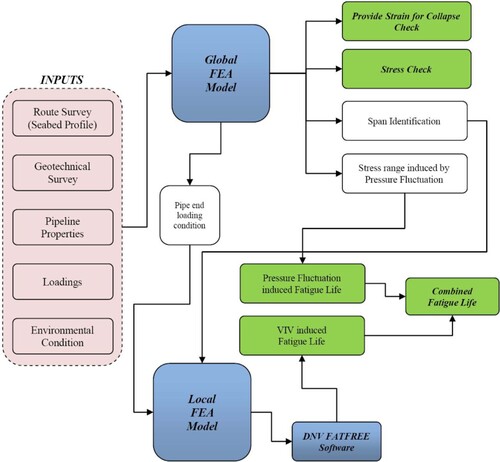
Figure 12. The crack growth analysis procedure using AI-FEM (Lee et al., Citation2022).
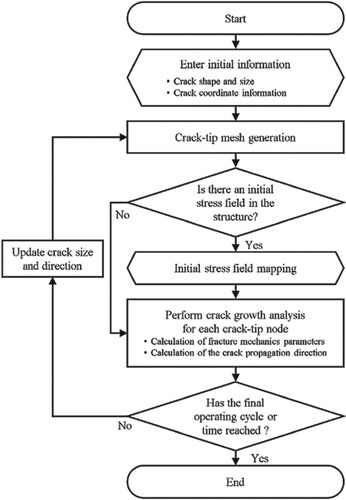
Qin & Cheng, Citation2021 recently published an extensive review discussing the assessment of internal and external corrosion defects in pipeline, along with contemporary multi-physics models. Additionally, Zakikhani et al., Citation2020 published another review focusing on the oil and gas pipelines’ failure prediction models. These review papers (Qin & Cheng, Citation2021; Zakikhani et al., Citation2020) identified the basic limitations of current prediction models of corrosion:
Complicated inspection programs and high-priced experiments are required for prediction models of corrosion.
The models mostly utilize limited failure data/ corrosion defects, however advanced simulation tools are important to address the uncertainties and lack of input data.
Older code-based methods, such as burst pressure criteria, tend to be overly conservative.
Due to the extreme complexity of modern models, it is essential to have in-depth knowledge of corrosion science, mechanics, electrochemistry, DL, FEA, and advanced numerical/computational approaches and modelling techniques.
Similarly, Xie et al., Citation2022 proposed a new method using FE modelling to estimate the stress intensity factor by calculating it using the crack surface widening energy release rate. Moreover, the effect of carbon on SCC in pipeline steels has also been recognized. Various studies have also focused on simulating mechanisms and modelling of SCC, including the use of FEA. Table presents prediction models using FEA on SCC in pipelines.
Table 2. Recent Studies using FEA for SCC in pipelines.
4.2. Challenges and limitations in FEA for SCC prediction
FEA is the most accurate assessment method in a corroded pipeline for SCC when compared with the conventional assessment standards. However, there are several challenges and limitations associated with FEA for SCC prediction. One of the major challenges for prediction models of corroded pipeline is the data uncertainty nature, which also makes difficulty to predict accurate SCC (Liu et al., Citation2022). FEA offers a potential avenue to address this challenge by facilitating the simulation of pertinent conditions and the generation of data. Nevertheless, it is important to acknowledge that the efficacy of FE modelling hinges on the availability of real-time or experimental data for validation purposes. The accuracy is also a difficulty in predicting the multiple corroded pipelines’ failure pressure subjected to axial compressive stress and internal pressure using FEA (Vijaya Kumar, Karuppanan, et al., Citation2021). Another the main challenge is the ability of industries to use advanced models for detection and prediction of SCC and performing automated risk analysis for SCC while integrating these solutions with existing process safety and control systems. Additionally, accurately building an FEA model is crucial for reliable prediction of pipeline profile, gap under all conditions, and free spanning length, which are important for the fatigue and stress assessment and design of free span mitigation (Huang et al., Citation2017). Furthermore, there is the varied influence factors, limited experimental conditions, and diverging experimental data, which create it complex for the prediction of stress corrosion crack growth behaviour accurately of dissimilar metal weld joints with complexity of geometry, material configuration, crack shape, and operating loads. (Zhao et al., Citation2014).
The prediction of SCC initiation, propagation, and growth with a high level of certainty currently lacks well-established methods, although NACE Standard RP0204-2004 provides guideline factors to analyse and methodologies to employ in order to predict the likelihood of SCC occurrence (Cote et al., Citation2010; Merle & Ehlers, Citation2006). Modelling intergranular SCC in pipelines is also important for predictive techniques that are integral to pipeline management and integrity (Griggs et al., Citation2016). The nonlinear behaviour of SCC also challenges the traditional modelling approaches (Andalib et al., Citation2022). The availability of reliable experimental data for validating SCC prediction models is limited. Obtaining experimental data under realistic conditions, including the combined effects of various factors, can be challenging. The lack of comprehensive and well-documented experimental data for SCC hinders the validation and refinement of FEA models (Qiu et al., Citation2017; Ryakhovskikh et al., Citation2021).
Performing extensive parametric studies using FEA can be impractical, and in this situation ML has shown to be useful (Vijaya Kumar, Lo Yin Kai, et al., Citation2021). In a recent article (Eastvedt et al., Citation2022), the effectiveness of ML algorithms in identifying the faults through analysis of the relationship between crude oil temperature, velocity change, and pressure change was explored. The research suggested that ML provides a cost-effective, accurate, and safe, means of monitoring subsea pipelines, without need of installing specialized equipment within the network of pipelines. This method has the potential to significantly elevate operational safety and safeguard ocean environments. Eventually, deep learning-enabled FEA combines the strengths of DL and FEA to predict the SCC in pipeline. The key advantage of deep learning-enabled FEA is its ability to learn from complex, high-dimensional data and capture non-linear relationships that may be challenging to model using traditional methods. The DNN architecture can automatically learn the important features and patterns within the data, leading to more accurate predictions of SCC initiation and propagation (Su et al., Citation2021). By analysing the learned features and patterns, researchers can gain a deeper understanding of the factors that contribute to SCC and develop effective mitigation strategies.
5. Deep learning-enabled FEA for SCC prediction
Deep learning (DL) approaches have been integrated with FEA to improve the predictive capabilities and automate analysis processes. DL algorithms can evaluate the large datasets, learn from patterns, and make predictions based on training (Wang et al., Citation2022). In FEA, DL is used for tasks like optimization, surrogate modelling, uncertainty quantification, and data-driven model calibration by combining the physics-based simulations of FEA. There’s one main limitation of DL that lies in its demand for extensive datasets to achieve optimal simulation results. However, this drawback can be mitigated by leveraging FEA to generate datasets after model validation, effectively reducing the reliance on vast amounts of big data while maintaining simulation accuracy. Recently, the integration of DL and artificial intelligence (AI) techniques with FEA has proved promising results in SCC prediction (Jung et al., Citation2020).
5.1. Introduction to deep learning and its application
There are different tasks such as multiplying large numbers or conducting search operations, are challenging for humans but can be easily performed by computers. On the other hand, tasks such as language conversations or driving are difficult for the machines to accomplish. AI is a field of study that aims to enable computers to perform tasks more efficiently than humans. DL is a subfield of AI that concentrates on training to learn and make predictions from large datasets. DL involves extracting meaningful features from the raw data by utilizing the multiple layers for determining the various aspects suitable to input data (Mishra et al., Citation2021). At its core, DL utilizes the artificial neural networks (ANNs) with multiple layers of interconnected nodes (neurons) to process and learn from the data. Each neuron receives input data, applies weights to the input, and passes it through an activation function to generate an output as shown in Figure (Sarwar et al., Citation2014; Tahan et al., Citation2016). The weights of the connections between neurons are adjusted during training to optimize the network's performance. In recent years, several advancements have been made in the DL approach. DL encompasses a variety of methods and architectures that aim to model and learn intricate patterns in data. Here are some common techniques of DL, which are usually applied for detection and prediction of the corrosion in pipeline as discussed below.
5.1.1. Data-driven approach
This technique involves collecting large datasets of pipeline characteristics, loading conditions, and SCC data. The data is then implemented to train the network, which can learn the complex relationships between pipeline characteristics, SCC, and loading conditions. Once it is trained, the network can predict the SCC for new pipelines. Oh et al., Citation2020 applied DNN algorithm for the burst pressure prediction of API 5L X-grade pipelines with a dent. The results were compared with FEA-based parametric study and experimental results, and it showed good agreement. DNN is a type of data-driven model that particularly refers to ANNs with multiple hidden layers.
5.1.2. Convolutional neural networks
Convolutional neural networks (CNNs) are the other type of DL commonly used for image recognition. CNNs have been adapted for the prediction of SCC by treating the pipeline images as inputs to the network. The pipeline images are then processed by CNNs, which can determine the features that are indicative of SCC. Bastian et al., Citation2019 presented a computer vision-based approach for the localization and classification of corrosion in oil and gas pipelines. The study compiled the dataset consisting of over 140,000 pipelines images with different degrees of corrosion and implemented CNNs to categorize the images of pipeline according to corrosion intensity.
5.1.3. Recurrent neural networks
Recurrent neural networks (RNNs) are also a type of DL normally used for natural language processing. RNNs have been adapted for the prediction of SCC by treating time-series data as inputs to the network. The time-series data can involve the pipeline temperature, stress, and humidity data. Shaik et al., Citation2022 proposed a RNNs-based method for predicting the life of pipeline with corrosion dimension classes exposed to critical condition monitoring.
5.2. Current state of literature on the application of deep learning-enabled finite element analysis in stress corrosion cracking
SCC is a significant and complex problem that affects many industrial applications, including the oil and gas industry, nuclear reactors, and infrastructure made of reinforced concrete. To address this issue, researchers are increasingly exploring the usages of deep learning-enabled FEA methods to identify and predict SCC. Currently, there exists a scarcity of research that employs DL-enabled FEA for addressing pipeline corrosion. Nonetheless, the integration of DL approaches with FEA models has witnessed notable utilization within alternative domains, particularly in the realm of structural engineering, demonstrating good accuracy and effective problem-solving capabilities. Su et al., Citation2021 proposed a ANN DL model based on FE simulation and experimental data for the failure pressure prediction of oil and gas defective pipelines. The author compared the calculation results of empirical formulae and FEA simulation and analysed minimum error 2.38% of the FEM results. A 6-D vector was selected as inputs, the rectified linear unit (ReLU) is chosen as the activation function, and seven hidden layers and 250 nodes in each layer are selected. Moreover, the data-driven model improves calculation speed by two orders of magnitude and thus achieves fast defect failure pressure evaluation.
Jung et al., Citation2020 proposed a deep learned FE method to generate stiffness matrix of FEs. The performance is demonstrated through various numerical problems. This study showed that DL-FE method can outperform existing finite elements. The computational time is also calculated and it’s proportional to number of weights in DNNs. Ma et al. (Citation2023) developed a theory-guided NN model-based method to predict the burst pressure of corroded pipelines, which can incorporate physical principles into the DL framework. The experimental and FE simulation data was used as input data to DL-based model. The results showed good accuracy compared with other models. Dong et al., Citation2023 proposed an element-based DL approach named DeepFEM approach for computational solid mechanics. The proposed approach has an inherent capability of approximating the solutions of partial differential equations with similar parameters. Moreover, it is easy and efficient to employ DeepFEM to solve inverse problems. The main characteristic of DeepFEM is that the element is implemented in DL-based methods to improve computational efficiency. There are a few more studies on how the integration between these two approaches (DL & FEA) can be achieved in different fields and their performance, as summarized in Table .
Table 3. Types of approaches for the integration of DL and FEA.
The robustness and accuracy of these models heavily rely on the several factors including network layers type, the network depth, the function chosen for each layer, the arrangement of different types of layers in the network, and the training data. Ferreira et al., Citation2021 developed a hybrid model to predict burst pressure of corroded pipeline using multiresolution analysis, numerical analysis and meta-models. FE models are validated against experimental work and then discrete wavelet transform is used as filter to reduce the data and for the parametrisation of remaining thickness. Later, DNN is trained with FEA outputs to get very fast and accurate results. These studies demonstrate the potential of FEA and DL algorithms in predicting the SCC in pipelines. In summary, it was observed that CNNs and DNNs DL algorithms have widely been implemented by several researchers for corroded pipeline assessment and prediction. Moreover, CNNs approach has been applied on corrosion images as input to model training process. On other hand, DNNs technique has been utilized data (sensor, inspection, etc.) as data-driven model. After drilling down, the visualization presented in Figure is obtained. As discussed above, very limited literature (206 only) is available belonging to DL, FEA, SCC, and pipeline. Moreover, it is also highlighted in Figure that the DL technique is being implemented in pipeline corrosion area after 2018.
Research into DL-enabled FEA for pipeline SCC prediction faces several significant limitations. First and foremost is the availability and quality of data (Alzubaidi et al., Citation2023). Obtaining comprehensive, high-quality datasets for training deep learning models can be challenging, particularly when dealing with sensitive industries such as oil and gas. DL techniques are also analysed to act as a black box, but they are interpretable as well (Munappy et al., Citation2022). The need for a method of interpreting DL, which is used to obtain the valuable motifs and patterns recognized by the network, is common in many fields. Data imbalance, where SCC instances are significantly outnumbered by non-crack cases, poses a challenge, as do the difficulties in generalizing models to new environments or unforeseen conditions. The computational resources required for training deep learning models for FEA can be substantial, potentially limiting access for smaller research facilities or organizations with budget constraints (Ahmed et al., Citation2023). Overfitting is a common issue with deep learning models, and controlling it is vital for reliable predictions. Addressing these limitations is essential to advance the effectiveness of deep learning-enabled FEA for SCC prediction in pipelines while ensuring the integrity and safety of critical infrastructure.
6. Emerging trends and future directions
The applications of artificial intelligence and DL in science and engineering have revolutionized the way engineers approach structural analysis, particularly with respect to SCC prediction in pipelines. One application of this approach is the development of DL-enabled FEA for pipeline SCC prediction. This technique combines the DL algorithms with FE methods for the better accuracy of predictions and decreases the reliance on traditional empirical models. This integration enables a fusion of physics-based understanding from FEA with the ability of DL to capture the complex patterns in SCC data. Subsequently, emerging trends and future directions of DL-enabled FEA for pipeline SCC prediction are promising. DL model has high accuracy and efficiency in prediction of offshore pipeline corrosion depth and can also resolve overfitting problem of algorithm training (Akhlaghi et al., Citation2023). Bhowmik, Citation2021 developed a DL-based image-processing model for automated corrosion detection and identification of offshore pipeline. Digital twin system is also used to collect, process and analyse the data. The results showed fast processing and 81% accuracy of correctly identifying and classifying the subsea pipeline corrosion. The use of DL has facilitated the detection and classification of different forms of pipeline damage, including cracks initiation, crack growth, and corrosion. Moreover, with the incorporation of computer vision technology and CNNs, DL allows for smart detection of pipeline damage and assists in capturing the nonlinear behaviour of pipeline structures.
Obtaining diverse and large datasets for training the DL models in the context of SCC can be challenging. Researchers are exploring techniques like data augmentation, transfer learning, and generative adversarial networks to minimize this limitation and develop robust models even with limited available SCC data. To address the SCC data imbalance challenge, Synthetic Minority Over-sampling Technique (SMOTE) is a preprocessing technique specifically designed to balance the class distribution of dataset. As DL models become more complicated, there is a need for explainability and interpretability. Researchers are working on methods to enhance the interpretability of these models, including visualization, and understanding of the features learned by the models. This helps support insights into the factors influencing SCC growth and builds trust in the predictions.
By integrating DL approaches with FEA models, this approach (hybrid model) aims to enhance the accuracy and efficiency in SCC prediction. It provides advantages like improved crack identification and prediction by capturing complex patterns in SCC data, handling limited data through techniques, real-time monitoring for proactive maintenance decision-making, and efforts towards explainability and interpretability of DL models. These trends and future directions hold great promise for improving the safety and maintenance strategies in the oil and gas industry.
7. Conclusion
In conclusion, this comprehensive review has shed light on the significant advancements in the field of pipeline integrity management, specifically in the context of SCC prediction. The integration of DL techniques with traditional FEA has demonstrated promising potential to transform the way authors address the critical issue of SCC in pipelines. By synthesizing and analysing the available literature, authors have gained valuable insights into the complex interactions between mechanical stress, material properties, and environmental factors that contribute to SCC. This integrated approach offers a powerful tool for enhancing the accuracy and efficiency of SCC prediction, ultimately leading to improved pipeline integrity management practices.
The advantages of DL-enabled FEA are evident in its ability to harness vast datasets, adapt to changing conditions, and uncover intricate patterns that may go unnoticed with conventional methods. Through various case studies and methodologies discussed in this review, authors have seen how DL algorithms can improve the accuracy of SCC prediction and reduce the risk of catastrophic pipeline failures. However, it is essential to acknowledge the limitations and challenges associated with this emerging approach. These challenges include the availability of limited data, complex model training, and the need for explainability and interpretability of DL models need to be addressed. Researchers are actively exploring solutions like data augmentation, transfer learning, and visualization approaches to overcome these challenges.
This review serves as a comprehensive resource for engineers, researchers, and practitioners interested in the recent advancements and future directions of DL-enabled FEA for the prediction of SCC in steel pipelines. By fostering continued exploration and innovation in this field, authors aim to contribute to safer, more reliable, and more cost-effective pipeline integrity management practices.
As the industry continues to evolve, the integration of DL into pipeline integrity management offers a promising path forward. With ongoing research and collaboration, authors can look forward to more robust, efficient, and accurate methods for mitigating the risks associated with SCC, ultimately ensuring the long-term integrity of the critical infrastructure.
Declaration of competing interest
The authors declare that they have no known competing financial interests or personal relationships that could have appeared to influence the work reported in this paper.
Data availability
No data was used for the research described in the article.
Disclosure statement
No potential conflict of interest was reported by the author(s).
Additional information
Funding
References
- Abubakar, S. A., Mori, S., & Sumner, J. (2022). A review of factors affecting SCC initiation and propagation in pipeline carbon steels. Metals, 12(8), 1397. https://doi.org/10.3390/met12081397
- Ahmad, Z. (2006). Principles of corrosion engineering and corrosion control. Elsevier.
- Ahmed, S. F., Alam, M. S. B., Hassan, M., Rozbu, M. R., Ishtiak, T., Rafa, N., … & Gandomi, A. H. (2023). Deep learning modelling techniques: Current progress, applications, advantages, and challenges. Artificial Intelligence Review, 1–97. https://link.springer.com/article/10.1007/s10462-023-10466-8/#citeas.
- Akhlaghi, B., Mesghali, H., Ehteshami, M., Mohammadpour, J., Salehi, F., & Abbassi, R. (2023). Predictive deep learning for pitting corrosion modeling in buried transmission pipelines. Process Safety and Environmental Protection, 174, 320–327. https://doi.org/10.1016/j.psep.2023.04.010
- Alamri, A. H. (2022). Application of machine learning to stress corrosion cracking risk assessment. Egyptian Journal of Petroleum, 31(4), 11–21. https://doi.org/10.1016/j.ejpe.2022.09.001
- Alzubaidi, L., Bai, J., Al-Sabaawi, A., Santamaría, J., Albahri, A. S., Al-dabbagh, B. S. N., Fadhel, M. A., Manoufali, M., Zhang, J., Al-Timemy, A. H., Duan, Y., Abdullah, A., Farhan, L., Lu, Y., Gupta, A., Albu, F., Abbosh, A., & Gu, Y. (2023). A survey on deep learning tools dealing with data scarcity: Definitions, challenges, solutions, tips, and applications. Journal of Big Data, 10(1), 46. https://doi.org/10.1186/s40537-023-00727-2
- Andalib, A., Aminnejad, B., & Lork, A. (2022). Compressive strength prediction of self-compacting concrete-a bat optimization algorithm based ANNs. Advances in Materials Science & Engineering. https://doi.org/10.1155/2022/8404774
- Askari, M., Aliofkhazraei, M., & Afroukhteh, S. (2019). A comprehensive review on internal corrosion and cracking of oil and gas pipelines. Journal of Natural Gas Science and Engineering, 71, 102971. https://doi.org/10.1016/j.jngse.2019.102971
- Baker, M. (2018). Pipeline corrosion - final report. Retrieved August 29, 2018, from https://www.phmsa.gov/pipeline/hazardous-liquid-integrity-management/pipeline-corrosion-final-report.
- Barbero, E. J. (2023). Finite element analysis of composite materials using abaqus®. CRC press.
- Bastian, B. T., Jaspreeth, N., Ranjith, S. K., & Jiji, C. V. (2019). Visual inspection and characterization of external corrosion in pipelines using deep neural network. NDT & E International, 107, 102134. https://doi.org/10.1016/j.ndteint.2019.102134
- Beavers, J., & Bubenik, T. A. (2017). Stress corrosion cracking. Trends in Oil and Gas Corrosion Research and Technologies, 295–314. https://doi.org/10.1016/B978-0-08-101105-8.00012-7
- Beavers, J. A., & Harle, B. A. (1996). Mechanisms of high-pH and near-neutral-pH SCC of underground pipelines. In International Pipeline Conference, American Society of Mechanical Engineers.
- Bennett, D. C. (1981). Continuous digester cracking task group reports on past year's efforts.
- Bhardwaj, U., Teixeira, A., & Soares, C. G. (2022). Failure assessment of corroded ultra-high strength pipelines under combined axial tensile loads and internal pressure. Ocean Engineering, 257, 111438. https://doi.org/10.1016/j.oceaneng.2022.111438
- Bhattacharyya, B. (2015). Recent advancements in EMM for micro and nanofabrication. In Electrochemical micromachining for nanofabrication, MEMS and nanotechnology (Chap. 12, pp. 219–240). William Andrew Publishers, ScienceDirect. https://doi.org/10.1016/B978-0-323-32737-4.00012-8
- Bhowmik, S. (2021). Digital twin for offshore pipeline corrosion monitoring: A deep learning approach. In Offshore Technology Conference. OTC.
- Bolandi, H., Li, X., Salem, T., Boddeti, V. N., & Lajnef, N. (2022). Bridging finite element and deep learning: High-resolution stress distribution prediction in structural components. Frontiers of Structural and Civil Engineering, 16(11), 1365–1377. https://doi.org/10.1007/s11709-022-0882-5
- Bony, M., Alamilla, J. L., Vai, R., & Flores, E. (2010). Failure pressure in corroded pipelines based on equivalent solutions for undamaged pipe. https://doi.org/10.1115/1.4001801
- Bueno, A., Moreira, E., & Gomes, J. (2014). Evaluation of stress corrosion cracking and hydrogen embrittlement in an API grade steel. Engineering Failure Analysis, 36, 423–431. https://doi.org/10.1016/j.engfailanal.2013.11.012
- Cicek, V. (2014). Corrosion engineering. John Wiley & Sons.
- Contreras, A., Hernández, S. L., Orozco-Cruz, R., & Galvan-Martínez, R. (2012). Mechanical and environmental effects on stress corrosion cracking of low carbon pipeline steel in a soil solution. Materials & Design, 35, 281–289. https://doi.org/10.1016/j.matdes.2011.09.011
- Contreras, A., Salazar, M., Carmona, A., & Galván-Martínez, R. (2017). Electrochemical noise for detection of stress corrosion cracking of low carbon steel exposed to synthetic soil Solution1. Materials Research, 20(5), 1201–1210. https://doi.org/10.1590/1980-5373-mr-2016-0183
- Cote, E. I., Ferguson, J., & Tehsin, N. (2010). Statistical predictive modelling: A methodology to prioritize site selection for near-neutral pH stress corrosion cracking. In International Pipeline Conference.
- Cunha, D. J., Benjamin, A. C., Silva, R. C. C., Guerreiro, J. N. C., & Drach, P. R. C. (2014). Fatigue analysis of corroded pipelines subjected to pressure and temperature loadings. International Journal of Pressure Vessels and Piping, 113, 15–24. https://doi.org/10.1016/j.ijpvp.2013.10.013
- Davis, J. R. (2000). Corrosion: Understanding the basics. Asm International.
- Dickinson, E. J., Ekström, H., & Fontes, E. (2014). COMSOL multiphysics®: finite element software for electrochemical analysis. A mini-review. Electrochemistry Communications, 40, 71–74. https://doi.org/10.1016/j.elecom.2013.12.020
- Dong, Y., Liu, T., Li, Z., & Qiao, P. (2023). DeepFEM: A novel element-based deep learning approach for solving nonlinear partial differential equations in computational solid mechanics. Journal of Engineering Mechanics, 149(2), 04022102. https://doi.org/10.1061/JENMDT.EMENG-6643
- DuBose, B. (2023). How stress corrosion cracking led to Arizona pipeline blast. https://www.materialsperformance.com/articles/coating-linings/2023/10/how-stress-corrosion-cracking-led-to-arizona-pipeline-blast.
- Eastvedt, D., Naterer, G., & Duan, X. (2022). Detection of faults in subsea pipelines by flow monitoring with regression supervised machine learning. Process Safety and Environmental Protection, 161, 409–420. https://doi.org/10.1016/j.psep.2022.03.049
- (EGIG), E.G.P.I.D.G. (2020). Gas Pipeline Incidents. 11th Report of the European Gas Pipeline Incident Data Group (period 1970–2019). Retrieved December 17, 2020, from https://www.egig.eu/reports.
- Engineers, A. S. O. M. (2012). Manual for determining the remaining strength of corroded pipelines: a supplement to ASME B31 code for pressure piping: An American National Standard. American Society of Mechanical Engineers.
- Fenta, Y. M., & Kamath, G. M. (2021). Active deep learning-based corrosion damage detection in aircraft structures. Structural Health Monitoring, 2021. https://doi.org/10.12783/shm2021/36295
- Fernandez-Navamuel, A., Zamora-Sánchez, D., Omella, Á. J., Pardo, D., Garcia-Sanchez, D., & Magalhães, F. (2022). Supervised deep learning with finite element simulations for damage identification in bridges. Engineering Structures, 257, 114016. https://doi.org/10.1016/j.engstruct.2022.114016
- Ferreira, A. D. M., Afonso, S. M. B., Willmersdorf, R. B., & Lyra, P. R. M. (2021). Multiresolution analysis and deep learning for corroded pipeline failure assessment. Advances in Engineering Software, 162, 103066. https://doi.org/10.1016/j.advengsoft.2021.103066
- Gadala, I. M., Abdel Wahab, M., & Alfantazi, A. (2018). Electrochemical corrosion finite element analysis and burst pressure prediction of externally corroded underground gas transmission pipelines. Journal of Pressure Vessel Technology, 140(1), https://doi.org/10.1115/1.4038224
- Gong, K., Wu, M., Liu, X., & Liu, G. (2022). Nucleation and propagation of stress corrosion cracks: Modeling by cellular automata and finite element analysis. Materials Today Communications, 33, 104886. https://doi.org/10.1016/j.mtcomm.2022.104886
- Griggs, J., Gamboa, E., & Lavigne, O. (2016). A review of modelling high pH stress corrosion cracking of high pressure gas pipelines. Materials and Corrosion, 67(3), 251–263. https://doi.org/10.1002/maco.201508454
- Huang, S., Sun, J., & Abdalla, B. (2017). Pipeline span assessment lessons learned from numerical simulations. In Offshore Technology Conference. OnePetro.
- IEA, I.E.A. (2022). World Energy Outlook 2022 shows the global energy crisis can be a historic turning point towards a cleaner and more secure future. Retrieved October 27, 2022, from https://www.iea.org/news/world-energy-outlook-2022-shows-the-global-energy-crisis-can-be-a-historic-turning-point-towards-a-cleaner-and-more-secure-future.
- Iqbal, H., Tesfamariam, S., Haider, H., & Sadiq, R. (2017). Inspection and maintenance of oil & gas pipelines: A review of policies. Structure and Infrastructure Engineering, 13(6), 794–815. https://doi.org/10.1080/15732479.2016.1187632
- Ji, M., Yang, M., & Soghrati, S. (2023). A deep learning model to predict the failure response of steel pipes under pitting corrosion. Computational Mechanics, 71(2), 295–310. https://doi.org/10.1007/s00466-022-02238-y
- Jiang, X., Qi, H., Qiang, X., Zhao, B., & Dong, H. (2023). A convolutional neural network-based corrosion damage determination method for localized random pitting steel columns. Applied Sciences, 13(15), 8883. https://doi.org/10.3390/app13158883
- Jung, J., Yoon, K., & Lee, P.-S. (2020). Deep learned finite elements. Computer Methods in Applied Mechanics and Engineering, 372, 113401. https://doi.org/10.1016/j.cma.2020.113401
- Katona, R., Burns, J. T., Schaller, R. F., & Kelly, R. G. (2022). Insights from electrochemical crack tip modeling of atmospheric stress corrosion cracking. Corrosion Science, 209, 110756. https://doi.org/10.1016/j.corsci.2022.110756
- Khan, K. S., Kunz, R., Kleijnen, J., & Antes, G. (2003). Five steps to conducting a systematic review. Journal of the Royal Society of Medicine, 96(3), 118–121. https://doi.org/10.1177/014107680309600304
- Kishawy, H. A., & Gabbar, H. A. (2010). Review of pipeline integrity management practices. International Journal of Pressure Vessels and Piping, 87(7), 373–380. https://doi.org/10.1016/j.ijpvp.2010.04.003
- Lee, G.-B., Park, S.-H., Jang, Y.-Y., Huh, N.-S., Park, S.-H., Park, N.-H., & Park, J. (2022). Development of automatic crack growth simulation program based on finite element analysis. Applied Sciences, 12(6), 3075. https://doi.org/10.3390/app12063075
- Li, K., & Zeng, Y. (2023). Long-term corrosion and stress corrosion cracking of X65 steel in H2O-saturated supercritical CO2 with SO2 and O2 impurities. Construction and Building Materials, 362, 129746. https://doi.org/10.1016/j.conbuildmat.2022.129746
- Liu, G., Ayello, F., Vervake, G., Beck, J., Thodla, R., & Sridhar, N. (2022, September). An integrated model for predicting stress corrosion cracking of buried pipelines. In International Pipeline Conference (Vol. 86564, p. V001T07A012). American Society of Mechanical Engineers. https://doi.org/10.1115/IPC2022-87136
- Liu, Z., Li, X., & Cheng, Y. (2012). Mechanistic aspect of near-neutral pH stress corrosion cracking of pipelines under cathodic polarization. Corrosion Science, 55, 54–60. https://doi.org/10.1016/j.corsci.2011.10.002
- Lo, M., Vijaya Kumar, S. D., Karuppanan, S., & Ovinis, M. (2022). An artificial neural network-based equation for predicting the remaining strength of mid-to-high strength pipelines with a single corrosion defect. Applied Sciences, 12(3), 1722. https://doi.org/10.3390/app12031722
- Lu, B., Luo, J., & Norton, P. (2010). Environmentally assisted cracking mechanism of pipeline steel in near-neutral pH groundwater. Corrosion Science, 52(5), 1787–1795. https://doi.org/10.1016/j.corsci.2010.02.020
- Ma, H., Zhang, W., Wang, Y., Ai, Y., & Zheng, W. (2023). Advances in corrosion growth modeling for oil and gas pipelines: A review. Process Safety and Environmental Protection, 171, 71–86. https://doi.org/10.1016/j.psep.2022.12.054
- Ma, Y., Zheng, J., Liang, Y., Klemeš, J. J., Du, J., Liao, Q., Lu, H., & Wang, B. (2022). Deeppipe: Theory-guided neural network method for predicting burst pressure of corroded pipelines. Process Safety and Environmental Protection, 162, 595–609. https://doi.org/10.1016/j.psep.2022.04.036
- Maduabuchi, C. (2022). Thermo-mechanical optimization of thermoelectric generators using deep learning artificial intelligence algorithms fed with verified finite element simulation data. Applied Energy, 315, 118943. https://doi.org/10.1016/j.apenergy.2022.118943
- Majchrowicz, K., Brynk, T., Wieczorek, M., Miedzińska, D., & Pakieła, Z. (2019). Exploring the susceptibility of P110 pipeline steel to stress corrosion cracking in CO2-rich environments. Engineering Failure Analysis, 104, 471–479. https://doi.org/10.1016/j.engfailanal.2019.06.016
- Menon, E. S. (2011). Chapter 13 - corrosion protection. In E. S. Menon (Ed.), Pipeline planning and construction field manual (pp. 293–304). Gulf Professional Publishing.
- Merle, A., & Ehlers, P. (2006). A statistical predictive model to prioritize site selection for stress corrosion cracking direct assessment. In International Pipeline Conference.
- Mishra, R. K., Reddy, G. S., & Pathak, H. (2021). The understanding of deep learning: A comprehensive review. Mathematical Problems in Engineering, 2021, 1–15. https://doi.org/10.1155/2021/5548884
- Moher, D., Liberati, A., Tetzlaff, J., & Altman, D. G. (2010). Preferred reporting items for systematic reviews and meta-analyses: The PRISMA statement. International Journal of Surgery, 8(5), 336–341. https://doi.org/10.1016/j.ijsu.2010.02.007
- Mok, D., Pick, R. J., Glover, A. G., & Hoff, R. (1991). Bursting of line pipe with long external corrosion. International Journal of Pressure Vessels and Piping, 46(2), 195–216. https://doi.org/10.1016/0308-0161(91)90015-T
- Mondal, B. C., & Dhar, A. S. (2019). Burst pressure of corroded pipelines considering combined axial forces and bending moments. Engineering Structures, 186, 43–51. https://doi.org/10.1016/j.engstruct.2019.02.010
- Mu, L., & Zhao, W. (2010). Investigation on carbon dioxide corrosion behaviour of HP13Cr110 stainless steel in simulated stratum water. Corrosion Science, 52(1), 82–89. https://doi.org/10.1016/j.corsci.2009.08.056
- Munappy, A. R., Bosch, J., Olsson, H. H., Arpteg, A., & Brinne, B. (2022). Data management for production quality deep learning models: Challenges and solutions. Journal of Systems and Software, 191, 111359. https://doi.org/10.1016/j.jss.2022.111359
- Nesic, S., Postlethwaite, J., & Olsen, S. (1996). An electrochemical model for prediction of corrosion of mild steel in aqueous carbon dioxide solutions. Corrosion, 52(4), 280–294. https://doi.org/10.5006/1.3293640
- Niazi, H., Chevil, K., Gamboa, E., Lamborn, L., Chen, W., & Zhang, H. (2020). Effects of loading spectra on high pH crack growth behavior of X65 pipeline steel. Corrosion, 76(6), 601–615. https://doi.org/10.5006/3472
- Niazi, H., Eadie, R., Chen, W., & Zhang, H. (2021). High pH stress corrosion cracking initiation and crack evolution in buried steel pipelines: A review. Engineering Failure Analysis, 120, 105013. https://doi.org/10.1016/j.engfailanal.2020.105013
- Ogawa, T., Itatani, M., Hayashi, T., & Saito, T. (2020, August). SCC growth prediction for surface crack in welded joint using advanced FEA. In Pressure Vessels and Piping Conference (Vol. 83860, p. V006T06A080). American Society of Mechanical Engineers. https://doi.org/10.1115/PVP2020-21670
- Oh, D., Race, J., Oterkus, S., & Koo, B. (2020). Burst pressure prediction of API 5L X-grade dented pipelines using deep neural network. Journal of Marine Science and Engineering, 8(10), 766. https://doi.org/10.3390/jmse8100766
- Omura, T., Amaya, H., Asahi, H., Sawamura, M., Kimura, M., & Ishikawa, N. (2009, March). Near neutral SCC properties of grade X80 linepipe. In NACE CORROSION (pp. NACE-09092). NACE.
- Orazem, M. (2014). Underground pipeline corrosion. Elsevier.
- Parkins, R. (1990). 1990 plenary lecture: Strain rate effects in stress corrosion cracking. Corrosion, 46(3), 178-189. https://doi.org/10.5006/1.3585089
- Parlak, B. O., & Yavasoglu, H. A. (2023). A comprehensive analysis of In-line inspection tools and technologies for steel oil and gas pipelines. Sustainability, 15(3), 2783. https://doi.org/10.3390/su15032783
- Petricca, L., Moss, T., Figueroa, G., & Broen, S. (2016, May). Corrosion detection using AI: a comparison of standard computer vision techniques and deep learning model. In Proceedings of the sixth international conference on computer science, engineering and information technology (Vol. 91, No. 2-16, p. p99). https://doi.org/10.5121/csit.2016.60608
- (PHMSA), P.a.H.M.S.A. (2018). Pipeline Failure Causes. https://www.phmsa.gov/incident-reporting/accident-investigation-division/pipeline-failure-causes.
- Qin, G., & Cheng, Y. F. (2021). A review on defect assessment of pipelines: Principles, numerical solutions, and applications. International Journal of Pressure Vessels and Piping, 191, 104329. https://doi.org/10.1016/j.ijpvp.2021.104329
- Qin, G., Cheng, Y. F., & Zhang, P. (2021). Finite element modeling of corrosion defect growth and failure pressure prediction of pipelines. International Journal of Pressure Vessels and Piping, 194, 104509. https://doi.org/10.1016/j.ijpvp.2021.104509
- Qin, G., Huang, Y., Wang, Y., & Frank Cheng, Y. (2023). Pipeline condition assessment and finite element modeling of mechano-electrochemical interaction between corrosion defects with varied orientations on pipelines. Tunnelling and Underground Space Technology, 136, 105101. https://doi.org/10.1016/j.tust.2023.105101
- Qiu, A., Han, X., Qin, H., Lin, W., & Tang, Y. (2017). Anti-Collision assessment and prediction considering material corrosion on an offshore protective device. Journal of Marine Science and Engineering, 5(3), 37. https://doi.org/10.3390/jmse5030037
- Rachman, A., Zhang, T., & Ratnayake, R. C. (2021). Applications of machine learning in pipeline integrity management: A state-of-the-art review. International Journal of Pressure Vessels and Piping, 193, 104471. https://doi.org/10.1016/j.ijpvp.2021.104471
- Rao, A. Y. (2021). Development of an artificial neural network model for predicting the stress corrosion cracking behaviors of nucler reactor internal structural materials. University of Florida.
- Rezayiye, R. K., Laurent, K., Nooralishahi, P., Ibarra-Castanedo, C., & Maldague, X. (2023). Thermal data augmentation approach for the detection of corrosion in pipes using deep learning and finite element modelling. Engineering Proceedings, 51(1), 20. https://doi.org/10.3390/engproc2023051020
- Roccisano, A., Nafisi, S., & Ghomashchi, R. (2020). Stress corrosion cracking observed in ex-service gas pipelines: A comprehensive study. Metallurgical and Materials Transactions A, 51(1), 167–188. https://doi.org/10.1007/s11661-019-05496-3
- Roewer-Despres, F., Khan, N., & Stavness, I. (2018). Towards finite element simulation using deep learning.
- Ryakhovskikh, I., Kashkovskiy, R., Kaverin, A., Stolov, V., & Zhedulov, S. (2021). Safe operation of gas pipelines based on the control of stress corrosion cracking. International Journal of Structural Integrity, 12(6), 864–877. https://doi.org/10.1108/IJSI-05-2021-0052
- Sarwar, U., Muhammad, M. B., & Karim, Z. A. (2014). Time series method for machine performance prediction using condition monitoring data. In 2014 International Conference on Computer, Communications, and Control Technology (I4CT). IEEE.
- Sastri, V. S. (2015). Challenges in corrosion: Costs, causes, consequences, and control. John Wiley & Sons.
- Shaik, N. B., Benjapolakul, W., Pedapati, S. R., Bingi, K., Thien Le, N., Asdornwised, W., & Chaitusaney, S. (2022). Recurrent neural network-based model for estimating the life condition of a dry gas pipeline. Process Safety and Environmental Protection, 164, 639–650. https://doi.org/10.1016/j.psep.2022.06.047
- Shuai, Y., Wang, X.-H., & Cheng, Y. F. (2020). Modeling of local buckling of corroded X80 gas pipeline under axial compression loading. Journal of Natural Gas Science and Engineering, 81, 103472. https://doi.org/10.1016/j.jngse.2020.103472
- Song, F. (2010). Predicting the effect of soil seasonal change on stress corrosion cracking susceptibility of buried pipelines at high pH. Corrosion, 66(9), 095004–095004-14. https://doi.org/10.5006/1.3490309
- Soomro, A. A., Mokhtar, A. A., Kurnia, J. C., Lashari, N., Lu, H., & Sambo, C. (2022). Integrity assessment of corroded oil and gas pipelines using machine learning: A systematic review. Engineering Failure Analysis, 131, 105810. https://doi.org/10.1016/j.engfailanal.2021.105810
- Su, Y., Li, J., Yu, B., Zhao, Y., & Yao, J. (2021). Fast and accurate prediction of failure pressure of oil and gas defective pipelines using the deep learning model. Reliability Engineering & System Safety, 216, 108016. https://doi.org/10.1016/j.ress.2021.108016
- Sun, H., Zhou, W., & Kang, J. (2021). A review of crack growth models for near-neutral pH stress corrosion cracking on oil and gas pipelines. Journal of Infrastructure Preservation and Resilience, 2(1), 1–15. https://doi.org/10.1186/s43065-021-00015-4
- Szabó, B., & Babuška, I. (2011). Introduction to finite element analysis: Formulation, verification and validation (Vol. 35). John Wiley & Sons.
- Tahan, M., Sarwar, U., Muhammad, M., & Abdul Karim, Z. A. (2016). Modeling and sensitivity analysis of a multi-nets anns model for real-time performance-based condition monitoring of an industrial gas turbine engine. ARPN Journal of Engineering and Applied Sciences, 11(24), 14269–14274.
- Vardhan, H., & Sztipanovits, J. (2022). Deep learning based fea surrogate for sub-sea pressure vessel. In 2022 6th International Conference on Computer, Software and Modeling (ICCSM). IEEE.
- Vijaya Kumar, S. D., Karuppanan, S., & Ovinis, M. (2021). Failure pressure prediction of high toughness pipeline with a single corrosion defect subjected to combined loadings using artificial neural network (ANN). Metals, 11(2), 373. https://doi.org/10.3390/met11020373
- Vijaya Kumar, S. D., Karuppanan, S., Perumal, V., & Ovinis, M. (2023). Failure pressure prediction of corroded high-strength steel pipe elbow subjected to combined loadings using artificial neural network. Mathematics, 11(7), 1615. https://doi.org/10.3390/math11071615
- Vijaya Kumar, S. D., Lo Yin Kai, M., Arumugam, T., & Karuppanan, S. (2021). A review of finite element analysis and artificial neural networks as failure pressure prediction tools for corroded pipelines. Materials, 14(20), 6135. https://doi.org/10.3390/ma14206135
- Völker, C., Kruschwitz, S., & Ebell, G. (2020). A machine learning-based data fusion approach for improved corrosion testing. Surveys in Geophysics, 41(3), 531–548. https://doi.org/10.1007/s10712-019-09558-4
- Wang, B., Liu, Y., Gao, Z., Zhang, T., Yang, F., & Li, S. (2021). Transition from pits to stress corrosion cracking of SAE 4120 steel in simulated oilfield environment. International Journal Of Electrochemical Science, 16(2), 21026.
- Wang, C., Zheng, J., Liang, Y., Klemeš, J. J., Zhu, Z., & Liao, Q. (2022). Deeppipe: An intelligent monitoring framework for operating condition of multi-product pipelines. Energy, 261, 125325. https://doi.org/10.1016/j.energy.2022.125325
- Wang, S., Niazi, H., Lamborn, L., & Chen, W. (2021). Strain-shock-induced early stage high pH stress corrosion crack initiation and growth of pipeline steels. Corrosion Science, 178, 109056. https://doi.org/10.1016/j.corsci.2020.109056
- Wang, Y., Zhang, P., & Qin, G. (2019). Non-probabilistic time-dependent reliability analysis for suspended pipeline with corrosion defects based on interval model. Process Safety and Environmental Protection, 124, 290–298. https://doi.org/10.1016/j.psep.2019.02.028
- Wasim, M., & Djukic, M. B. (2022). External corrosion of oil and gas pipelines: A review of failure mechanisms and predictive preventions. Journal of Natural Gas Science and Engineering, 104467.
- Wei, L., Pang, X., & Gao, K. (2016). Effect of small amount of H2S on the corrosion behavior of carbon steel in the dynamic supercritical CO2 environments. Corrosion Science, 103, 132–144. https://doi.org/10.1016/j.corsci.2015.11.009
- Wu, Y., & Li, J. (2019). Finite element analysis on mechanical behavior of semi-exposed pipeline subjected to debris flows. Engineering Failure Analysis, 105, 781–797. https://doi.org/10.1016/j.engfailanal.2019.06.055
- Xie, M., Wang, Y., Xiong, W., Zhao, J., & Pei, X. (2022). A crack propagation method for pipelines with interacting corrosion and crack defects. Sensors, 22(3), 986. https://doi.org/10.3390/s22030986
- Ying, W., Sixi, Z., & Pengwei, J. (2019). Finite element method simulations to study factors affecting buried pipeline subjected to debris flow. Journal of Pressure Vessel Technology, 141(2), 021701. https://doi.org/10.1115/1.4042055
- Zakikhani, K., Nasiri, F., & Zayed, T. (2020). A review of failure prediction models for oil and gas pipelines. Journal of Pipeline Systems Engineering and Practice, 11(1), 03119001. https://doi.org/10.1061/(ASCE)PS.1949-1204.0000407
- Zhang, C., Ran, M., Wang, Y., & Zheng, W. (2022). Microstructural effects in the development of near-neutral pH stress corrosion cracks in pipelines. Materials, 15(13), 4372. https://doi.org/10.3390/ma15134372
- Zhang, H., & Tian, Z. (2022). Failure analysis of corroded high-strength pipeline subject to hydrogen damage based on FEM and GA-BP neural network. International Journal of Hydrogen Energy, 47(7), 4741–4758. https://doi.org/10.1016/j.ijhydene.2021.11.082
- Zhang, L., Cheng, L., Li, H., Gao, J., Yu, C., Domel, R., Yang, Y., Tang, S., & Liu, W. K. (2021). Hierarchical deep-learning neural networks: Finite elements and beyond. Computational Mechanics, 67(1), 207–230. https://doi.org/10.1007/s00466-020-01928-9
- Zhang, T., Shuai, J., Shuai, Y., Hua, L., Xu, K., Xie, D., & Mei, Y. (2023). Efficient prediction method of triple failure pressure for corroded pipelines under complex loads based on a backpropagation neural network. Reliability Engineering & System Safety, 231, 108990. https://doi.org/10.1016/j.ress.2022.108990
- Zhang, Y., Xiao, Z., & Luo, J. (2018). Fatigue crack growth investigation on offshore pipelines with three-dimensional interacting cracks. Geoscience Frontiers, 9(6), 1689–1697. https://doi.org/10.1016/j.gsf.2017.09.011
- Zhang, Z., Ni, X., & Cheng, Y. F. (2020). Assessment by finite element modelling of the mechano-electrochemical interaction at double-ellipsoidal corrosion defect with varied inclinations on pipelines. Construction and Building Materials, 260, 120459. https://doi.org/10.1016/j.conbuildmat.2020.120459
- Zhao, L., Xue, H., Yang, F., & Suo, Y. (2014). Numerical investigation on stress corrosion cracking behavior of dissimilar weld joints in pressurized water reactor plants. Frattura ed Integrità Strutturale, 8(29), 410–418. https://doi.org/10.3221/IGF-ESIS.29.36
- Zhou, R., Gu, X., & Luo, X. (2023). Residual strength prediction of X80 steel pipelines containing group corrosion defects. Ocean Engineering, 274, 114077. https://doi.org/10.1016/j.oceaneng.2023.114077
- Zhu, M., Du, C., Li, X., Liu, Z., Wang, S., Zhao, T., & Jia, J. (2014). Effect of strength and microstructure on stress corrosion cracking behavior and mechanism of X80 pipeline steel in high pH carbonate/bicarbonate solution. Journal of Materials Engineering and Performance, 23(4), 1358–1365. https://doi.org/10.1007/s11665-014-0880-4
- Zhu, W., Sun, D., Xie, F., Wu, M., Xu, Y., & Ren, S. (2023). Effects of corrosion defect growth on submarine pipeline under operating pressure and axial displacement. Ocean Engineering, 267, 113297. doi:10.1016/j.oceaneng.2022.113297

